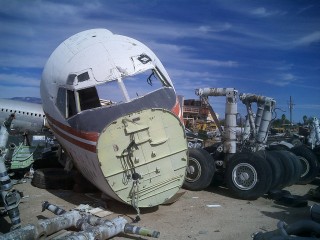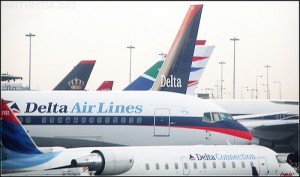
I wanted to find a sad picture that made me feel disapointed. I think this one does nicely. That is an old TWA 707 nose and landing gear located in Tuscon, AZ.
While US House leaders start summer recess today, there are still 4,000 Federal Aviation Administration (FAA) employees that will remain furloughed and about 70,000 construction and support workers that will not have jobs until the the recess concludes on September 6th. Of course there are no guarantees that congress can even come to an agreement when they return. Due to the lack of cooperation, the FAA will continue to lose about $30million per day totaling over $1billion during the recess.
According to CNN, representatives continued to argue, “over an issue they said was the real subject of the dispute — new National Mediation Board rules that make it easier for airlines to unionize. Democrats favor the new rules; Republicans oppose them.”
While the country has been concerned about the raising of the debt ceiling, not as much attention has been given to the funding issues facing the FAA. Not everyone is losing due to the shutdown — at least for the short term. As part of the shut down, FAA taxes are not longer being collected by airlines and some have decided to pass the savings on to passengers, while others decided to keep the additional funds to offset the increase in fuel prices. While it seems that passengers and airlines are celebrating the savings, long-term it will only end up hurting airline infrastructure.
If passengers purchased tickets for travel after July 23rd and paid the taxes, they have the option to request a refund from the IRS. Delta Air Lines is hoping to make the process much easier, by offering the IRS tax refund directly though them.
Part of me wants to support the effort of passengers getting their refunds, since it is the government who messed up and they should be “punished” by having to give tax money back. However, the airline part of me feels that asking for a refund will just further hurt the airline industry and I rather “donate” my taxes I already paid.
This story is extremely angering and is NOT okay. The airline infrastructure and hard working employees should not be suffering while members of our political system go on holiday. I do not think that most politicians realize that their school-yard politics actually affects real people and this inability to work together will have a negative impact that will be felt for a long time.
Image: Telstar Logistics

Bunch of traffic at New York's JFK Airport.
Be careful what you ask for…
I am sure you have heard on the news about passengers being stuck in planes for hours and hours with little food and water. Is that a fun experience? Heck no.
When I was a teenager I was stuck on the tarmac for over five hours and it was not a pleasant experience. However, after the five hours I got to fly home to my family. My flight was from Seattle, WA to Reno, NV and we had to be diverted to San Jose, CA due to poor weather. With the new rules going into affect in two days, I could have been stuck at an unfamiliar airport, with no family and no real money.
Over the past few years, quite a few airlines have made the news for leaving passengers stuck on the runway for hours; passengers got angry. Some passengers got REALLY angry. They wanted the government to step in and make sure no other passenger had to be stuck on the tarmac for long periods of time again.
To me, being stuck on the plane was not a fun experience, but it is life, it happens. No matter the form of transportation I would have used, the end result would have been the same — delayed due to the weather.
The new rules, starting April 29th, state that an airline will have to allow passengers to disembark if they have been sitting on the tarmac for three hours, unless doing so would jeopardize safety. The new rule sounds like a pretty good deal for passengers in theory, but in reality, I think it will cause a lot more frustration, loss of money and even more angry passengers.
With the new rules, an airline can be charge up to $27,500.00 per passenger that is left on an airplane for more than three hours. That is a lot of money. If an airline sees that a flight might be delayed for three hours, instead of waiting, they might just cancel the flight. This doesn’t mean that the plane will just sit around waiting. That plane needs to be at the next destination. It might have to fly empty to pick up the next set of passengers. If it doesn’t, routes all over will be delayed and even more passengers will be upset and more revenue will be lost.
That leaves the question: Would you rather be stuck on a plane for four hours and reach your destination? Or would you rather be stuck in a city, sleeping in the airport for much longer…possibly days?
What’s worse is New York’s JFK airport is already known for their long delays. Right now their main runway is closed for some improvements. Because of this, some airlines have asked for an exception from the three hour rule, but they were denied. Remind me not to fly out of JFK for the next few weeks!
Again, this is another time where the government should not be interfering with the airlines. Already airlines get a bad rap if they leave passengers in the airplane for hours. The mainstream media loves to bash them.
The airline business is extremely complicated and that is when things go right. Throw in bad weather, aircraft issues, scheduling problems, huge pressure for the lowest prices, and security and you have a business just waiting for things to go wrong.
For me, I would rather be stuck on an airplane going no where for a few hours, than not being able to reach my destination. I can easily survive a few hours without food and water and waiting inside an airplane is a heck of a lot better than trying to take a bus.
Image: matt.hintsa
connect | web | twitter | facebook |

It fits!
Rep Dan Lipinski from Illinois feels it is a good idea for the TSA to have a uniform carry-on size regulation. He wants to limit the maximum size of a carry-on to 22″ x 18″ x 10″. It is not the size that is as disconcerting, as not allowing the airlines to make their own decisions and the total lack of need for this legislation
Each airline flies different aircraft, have different configurations and clientele with different baggage needs. The bill would require the TSA to enforce the rules (presumably during the security check process). Although TSA has made leaps and bounds with speeding up the security process, this could greatly slow it down. People would be having to take stuff out, trying to cram their bags through and of course having to leave the line to check in their bags and come back through.
CrankFlier points out that many low cost airlines have their “minimum size” larger than what Rep Lipinski is asking for, and legacy carriers are already meeting the requirements. The low cost carriers would have to cut what they already offer.
What is the real reason for this? I don’t see a safety issue here, I would like to see someone try to make a valid one. In fact this would decrease safety. The TSA would have to police bag-size instead of doing what they are trained and look for illegal items taken through security.
This seems like a waste of time and legislation that will really hold no benefit. If airlines want to get together to create their own standard carry-on size, that is one thing, but for the government to come in and require standardization seems unnecessary.
UPDATE: FlyWithFish.com has a great chart showing all the airlines and their bag size requirements.
Image: FlyingWithFish

Landing at Branson, MO's BKG airport.
Branson, Missouri is the home to the United State’s first privately supported airport. The $155 million airport is the first of 552 airports with commercial air service to receive no federal funding.
The town only has about 6,000 residents, but has over 50 theaters, ten museums, and a few other odds and ends that draw about 8million tourists to the area each year.
In 1996 Congress changed legislation that allowed airports to try and win over private investors and Branson will show if this is a feasible business plan. SO far two other airports have unsuccessfully tried to make airport privatization work (Midway Airport and Steward Airport). Currently only low-cost carriers Sun Country Airlines and AirTran Airways fly into Branson Airport (BKG).
There seems to be a lot of money making potential in airports (selling name rights, hotels, shops, restraunts, business deals, etc) and although airports around the globe have made leaps and bounds as far as amenities avliable, I wonder what new ideas a privatly-held, purely profit driven, airport can come up with.
Source: Dallas News Image: FlyBranson.com



